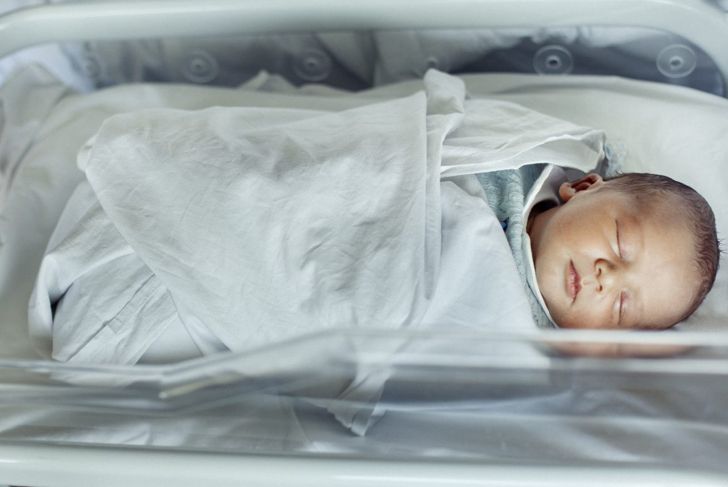For thousands of years, swaddling babies was a common practice in infant care. Historians believe swaddling began in Central Asia in 4000 BC, eventually spreading to the Western world. Swaddling techniques were much more restrictive back then: caretakers completely immobilized babies by wrapping them tightly in strips of cloth. During the 18th century, parents stopped swaddling, but the practice surged in popularity again during the 20th and 21st centuries. Today, there are specific dos and don’ts when it comes to swaddling, but when done correctly, it can be an effective and soothing technique for infants.
What is Swaddling?
Research shows that birth and labor cause the production of fetal stress hormones in newborns. Although these hormones help the infant adapt to their new life outside the womb, midwives or nurses may swaddle a newborn to comfort them. Wrapping babies snugly from the neck down in a blanket, with only their head exposed, makes them feel cozy and warm like they are back inside the womb. Studies show the practice improves quality of sleep for babies with colic, those born with drug addictions, or those who have neurological issues. There are a few methods of swaddling and two conventional types: diamond and square. You’ll find the steps for these methods at the end of this article.
Sleep Sacks
Another type of swaddle is the sleep sack, an oversized, wearable blanket that manufacturers designed to replace loose blankets in the crib. The sleep sack allows the baby’s legs to bend and cross over as they did in the womb. Proponents say the sack is beneficial because the baby can’t kick it off, and the child sleeps better because they are comfortable and warm. However, some parents say they prefer traditional methods of swaddling.
Swaddling and the ABCs of Safe Sleep
Sudden infant death syndrome (SIDS) is a major concern for most new parents. While some research suggests a connection between swaddling and SIDS, other studies indicate that it may reduce the risk. Because the evidence does not agree, the American Academy of Pediatrics does not officially recommend the practice, although they say safe swaddling can help soothe a colicky or fussy baby. Pediatric experts suggest parents consult with their child’s pediatrician and follow the ABCs of Safe Sleep: infants should sleep Alone, on their Backs, and in a Crib.
Sleeping Risks and Swaddling
Up to three months old, babies sleep between 15 to 16 hours each day. Swaddling increases a baby’s sense of security and comfort. It not only encourages longer sleep periods, but it also prevents infants from waking up so easily. But swaddling can also make it harder for the baby to wake up. Pediatricians say this decreased arousal is one of the primary reasons for SIDS death.
Overheating Risks and Swaddling
Baby’s lose body heat rapidly — about four times faster than adults — so it’s important to keep them warm. However, it’s not safe for an infant to be too warm, either. Studies show that because infants cannot regulate their body temperatures well, they are sensitive to the extremes. Heavy clothing or blankets, in combination with swaddling and warm rooms, can lead to overheating and an increased SIDS risk. Pediatricians warn parents not to overdress infants and never to cover the child’s face or head while they are sleeping.
Swaddling and Hip Dysplasia
Improper swaddling can loosen the hip joints, or lead to soft cartilage damage in the hip sockets or developmental hip dysplasia. When a baby is in the mother’s womb, the legs are bent up and cross each other. The sudden straightening of the legs after birth loosens the joints and can cause complications. Tight swaddling, along with stretching the infant’s legs straight out with the thighs pressed together, increases the risk by forcing the hips to move upward and away from the socket wall. Physicians say it’s important that swaddled babies have free movement of the legs, and that their knees are slightly flexed.
Swaddling and Baby Sleep Positions
A study investigating possible connections between swaddling and SIDS found that swaddled infants were at a higher risk for SIDS if their caretakers laid them on their sides, and this risk doubled when they were laid on their stomachs, especially at six months and older. Researchers theorize that swaddled babies laid in these positions are unable to lift their heads if they start having breathing issues. If the caretaker places the child face down to sleep and the blanket loosens, it could smother the child.
Vitamin D Deficiency
Around one billion people have vitamin D deficiencies. The lack of this essential steroid hormone leads to seasonal respiratory illnesses and infections. Researchers say there is a connection between swaddled infants and vitamin D deficiencies in certain cultures. Parents in some countries swaddle their infants when they’re outdoors, which prevents adequate sun exposure, one of the easiest ways for humans to acquire vitamin D.
The Diamond Swaddling Method
It’s important to swaddle correctly and to stop swaddling once your baby starts to roll over, usually around two months.
- Spread a blanket out on a flat surface, diagonally, like a diamond.
- Fold the top corner down to create a straight edge across the top.
- Lay the baby face up on the blanket, with the shoulders on the folded edge.
- Tuck the baby’s left arm down, bring the left corner over the chest, and tuck it under the right side.
- Bring the right arm down close to their body and the right corner of the blanket over the chest. Tuck under the baby’s left side.
- Bring the bottom corner of the blanket up, cover the legs, then twist the blanket corner, and tuck it under the baby. Some parents tie a knot in the twist.
Steps for the Square Swaddling Method
As with the diamond method of swaddling, the square method prevents constriction of the legs and hips, which can cause hip dysplasia.
- Spread a square blanket out on a flat surface.
- Place the baby’s shoulders even with the top of the blanket.
- Tuck the left arm down, bring the left side of the blanket over the baby’s chest and tuck under the right side of the baby.
- Then, tuck the baby’s right arm down, and bring the right side of the blanket over the arm and chest, and tuck it under the baby’s left side.
- Bring the bottom of the blanket up, and over the legs to the chest, making sure it is loose enough to allow free movement of the legs.

 Home
Home Health
Health Diet & Nutrition
Diet & Nutrition Living Well
Living Well More
More




















